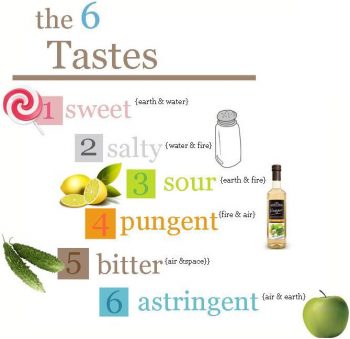How Taste Relates to the Elements
Ayurveda regards food in a very unique and integrated way. Understanding the principles of Ayurveda will help one to recognize the foods that will keep one’s self in complete balance & harmony.
Each kind of food, herbs and spices is made up of certain qualities, eg. popcorn is light & dry, chilli is hot & sharp, & ice-cream is cold & heavy. These qualities have a direct effect on how the body accepts and digests a particular food, even one’s emotional outlook can be directly affected, such as the mind feeling sharp and irritable after eating chilli.
In general when the qualities of a food is similar to the qualities of a dosha, this will tend to be aggravating, you see “like will always increase like”, so coming in with the opposite of food will always be balancing to the mind & body. This fundamental principle is the key in choosing the right foods for your constitution.
So in choosing the right foods that suit you, we also need to consider and understand that taste of a food, which also has an important quality that has a direct effect on the dosha. Each food substance has a specific taste. The moment a substance enters the mouth & touches the tongue the first experience is the taste.
Ayurveda recognizes six basic tastes, Sweet, Salty, Sour, Pungent, Bitter & Astringent.
Every food is made up of some combination of the 5 elements, Air, Ether, Fire, Water & Earth, so therefore these elements are present in each of the six tastes.
| Tastes | Elements |
|---|---|
| Sweet | Earth + Water |
| Sour | Earth + Fire |
| Salty | Water + Fire |
| Pungent | Fire + Air |
| Bitter | Air + Space |
| Astringent | Air + Earth |
The chart shows the relationship between the elements and the tastes.
The fire and air elements are light & tend to move upwards, hence the tastes
containing these elements also move up & heat the upper parts of the body producing lightness.
The opposite tends to happen in the earth & water elements, both being heavy & move downward, so the sweet taste therefore cools the lower part of the body producing heaviness in the body.
Actions of Tastes
Sweet
The taste of sweet is present in foods such as milk, sugar, rice, wheat, & maple syrup.
The qualities are usually oily, cooling & heavy. The sweet taste increases the vital essence of life, giving strength & longevity. When used moderately, it is wholesome to the body and nourishing to all of the 7 tissues, plasma, blood, muscles, fat, bone, marrow, & reproductive fluids.
It encourages the senses, improves complexion, promotes healthy skin & hair, is very grounding for both Vata & Pitta constitutions but increases Kapha.
Sweet taste can relieve thirst, & relieve burning sensations cooling the body down.
Excessive use can produce diseases of Kapha like diabetes, oedema, cysts and enlargement of malignant tumours. Other symptoms created by blocking of pathways within the body may cause colds, cough, & congestion.
Salty
Salty taste is found in sea salt, condiments like soy sauce, ketchup, fetta cheese, salt water fish like salmon, sardines & Tuna.
Salty is heating, heavy & oily in nature. When used moderately, it relieves Vata, increases Pitta & Kapha. When taken in moderation, it promotes growth & maintains water electrolyte balance. It also stimulates salivation, improves flavour of food, aids digestion, absorption & elimination of wastes.
Too much salt causes aggravation to Pitta & Kapha, it causes the blood to thicken causing high blood pressure. Other symptoms include fainting, overheating throughout the body, wrinkling on the face, greying of the hair, baldness and water retention.
Exception is Rock salt.
Sour
The taste of Sour is found in foods like citrus fruits like lemon, sour cream, yogurt, cheese, green grapes, granny smith apples, vinegar, & fermented foods like wine and sauerkraut.
Sour substances are liquid, light, heating, & oily in nature. When used in moderation, they are refreshing & stimulate appetite, improve digestion, energise the body, nourish the heart, enlighten the mind & cause salivation. It nourishes all tissues except the reproductive tissue. Great for Vata, increases Pitta & Kapha.
In excess, sour can cause sensitive teeth, excessive thirst, gas & wind, heartburn, acid reflux, indigestion & ulcers.
As Sour taste has a fermentation action, it is toxic to the blood causing skin conditions like acne, eczema, psoriasis & boils. The hot qualities may lead to acidity in the body & may cause burning in the throat, chest, heart, bladder & urethra.
Pungent
The pungent taste is present in foods such as eggplant, onions, chilli, garlic, ginger, paprika, rosemary, sage, spinach, beef, & wholegrain mustards.
It is light, drying & heating in nature. It soothes Kapha but ignites Vata and Pitta.
When used in moderation, it improves digestion & absorption. It clears the sinuses, removing phlegm by stimulating nasal secretions. It aids circulation, removes obstructions & brings clarity of perception.
In excess pungency may cause negative effects too, depleting reproductive tissue killing off sperm & ova. It may induce burning, choking, fainting, fatigue with heat & thirst, diarrhoea, heartburn & nausea.
From overuse of pungent taste in Vata types may cause symptoms as giddiness, tremors, insomnia, and pain in leg muscles.
Bitter
Examples of bitter taste are found in foods like rhubarb, coffee, turmeric root, fenugreek & aloe vera. It is cool, light, & dry in nature. It increases Vata, decreases Pitta & Kapha. Though bitter is not delicious in itself, it promotes the flavour of other tastes.
It helps to relieve burning sensations, itching, fainting, reduces fever & kills germs. In small doses, it can relieve intestinal gas & works as a digestive tonic.
Over-consumption of the bitter taste may deplete plasma, blood, muscles, fat, bone marrow & semen, which may result in sexual debility.
Extreme dryness causes emaciation & induce dizziness and unconsciousness.
Astringent
This taste is present in foods such as unripe banana, persimmons, chickpeas, pomegranate, yellow split peas, green beans, turmeric, in tea & many salad greens.
It produces a typical drying, choking sensation in the throat, is therefore cooling, drying and heavy in nature.
When taken in moderation, it calms Pitta & Kapha but aggravates Vata.
The taste of astringent absorbs water, causing dryness of the mouth, difficulty of speech & constipation.
It aids in healing ulcers, & stops bleeding by promoting clotting.
Excessive use may cause choking, absolute constipation, obstruction of voice, heart spasm, & stagnation of circulation. Emaciation, convulsion, Bell’s pulsy, stroke paralysis & other neuromuscular vata disorders are some of the affects astringent taste may have on the body.
Virya, Heating or Cooling Energy
After we experience the taste of food in the mouth, later or in some cases immediately, you feel its heating or cooling effect on the body. This is due to its action called Virya.
By self-experience one can determine and can form a general rule about what a taste feels like in the body. For example, the pungent taste of chilli has a heating effect on the body, you will feel the effects instantly, sweating on the forehead, sometimes even a headache.
Vipak - Post Digestive Effect
The final post digestive effect of taste on the body, mind & consciousness is called Vipak.
Sweet & Salty tastes have a sweet post digestive effect, sour taste has a sour vipak, but pungent, bitter & astringent all have a pungent effect on the body. So taking this into consideration one might look at how we traditionally have our meal at the moment. Main meal is always the first dish we have, then sometimes fruit, then dessert.
If we don’t want to cause indigestion we should follow the tastes in order of sequence, as is Sweet, Salty, Sour, then with the other tastes to follow. This will cause no disruption to the digestive process if followed. If you decide to have a sweet right at the end of a meal allow 2 hours after or have it another time, and never have fruit too close to your meal either.
Indian & Asian cultures seem to get it right with their food having a balanced meal incorporating all tastes and adding spices to enhance their digestion, so all tastes are digested properly at the same time without causing ill effects and creating ama, toxicity in the body.
Prabhav - The Specific Unexplained Action
When 2 substances of similiar taste, energy & post digestive effect show entirely different actions, this is called Prabhav. eg. ghee(clarified butter) in doses of 2 tsp with a cup of milk is laxative but in a smaller dose, like half tsp is constipating, there is no logic theory to this, only to say it is Prabhav.
According to Ayurveda, each taste used together or individually in the appropriate dose brings about balance of all the bodily systems & brings Vibrant Health, happiness & good health to all.
If one knows the taste, energy & post digestive effect of a food, it is simple to understand its actions on the human being, this knowledge is necessary for both healing & for use in daily cooking, so remember “Let Food be Thy Medicine and Medicine Be Thy Food” the famous quote by Hippocrates.
My mission in life is to empower you to take control of your own health & destiny, gaining knowledge & a sense of freedom, so you too can have the life you deserve, & to live to your full potential
References taken from books “Ayurvedic Cooking for Self-Healing” by Usha Lad & Dr Vasant Lad, and “Ayurveda, The Science of Self-Healing” by Dr. Vasant Lad

